To configure the WhatsApp Bot service, you must enter https://albiwsp.arandasoft.com/ or, if the client has its own implementation of the Bot, enter the access URL.
Login in the Bot environment
1. In the Section Login of the bot environment, enter the following data in the requested fields and click the Enter
| Field | Description |
|---|---|
| BackEnd Url | Aranda Service Management (ASMS) User Console URL https://(Domain)/ASMSCustomer/ |
| Version | When you select version 9, if the environment to be configured has the functionality of reCAPTCHA on the admin site, then the reCAPTCHA will be activated on the page. See reCAPTCHA ↪ configuration |
| User | WhatsApp Manager user (wmanager) |
| Password | WhatsApp Manager user password |
| Phone number identifier | Data that was saved when Obtained the number identifier |
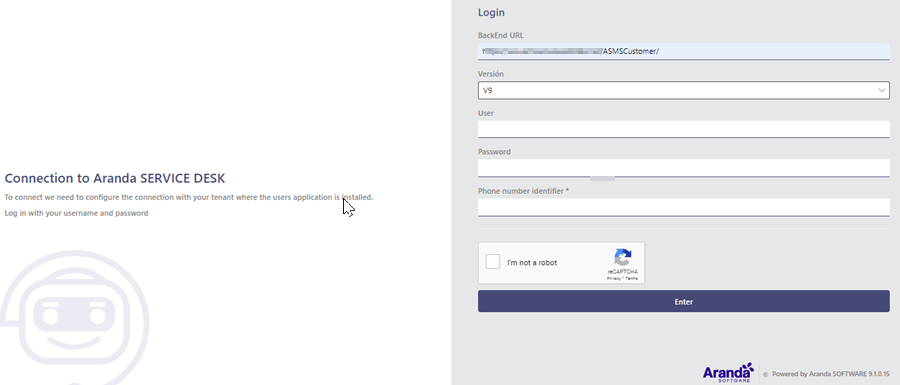
⚐ Note: When connections are already configured, the login must be made with the USDK BackEnd URL of the connection that is currently active. If the URL of any connection other than the configured one is entered, the following message will be displayed:
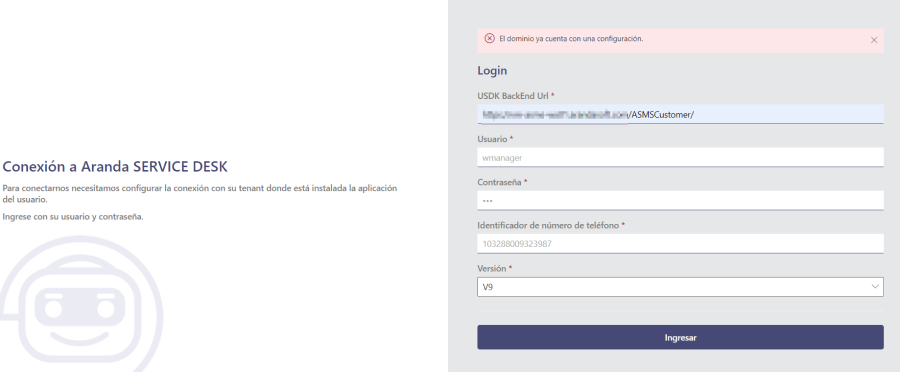
Account Setup in the Bot Environment
1. When you log in for the first time, a pop-up window will appear New Settings where the requested fields must be completed and then click on the Create.
| Field | Description |
|---|---|
| Configuration Name | Name that identifies the connection |
| URL del FrontEnd | Aranda Service Management Users Web Console URL (ASMSCustomer) https://(Domain)/ASMSCustomer/ |
| URL del BackEnd | Aranda Service Management Users Web Console URL (ASMSCustomer) https://(Domain)/ASMSCustomer/ |
| Version | When you select version 9, if the environment to be configured has the functionality of reCAPTCHA on the admin site, the ‘Integration token’ field will be enabled. Previously, an integration token must be generated with the WhatsApp Client user and set it in this field. See Configuring Integration ↪ Tokens |
| User | WhatsApp Client user (wclient) |
| Password | WhatsApp Client User password |
| Phone number identifier | Data that was saved when Obtained the number identifier Loads by default |
| Project | Project code to automatically select the default project when creating cases anonymously. (Optional) |
| Active | Enable/Inactivate the setting |

2. If the configuration is correct, the following window will appear with the configuration made.

3. To create new connections, click the New;
To edit an existing connection, click the pencil icon, to complete
the respective information. When finished, click the Create/Update.
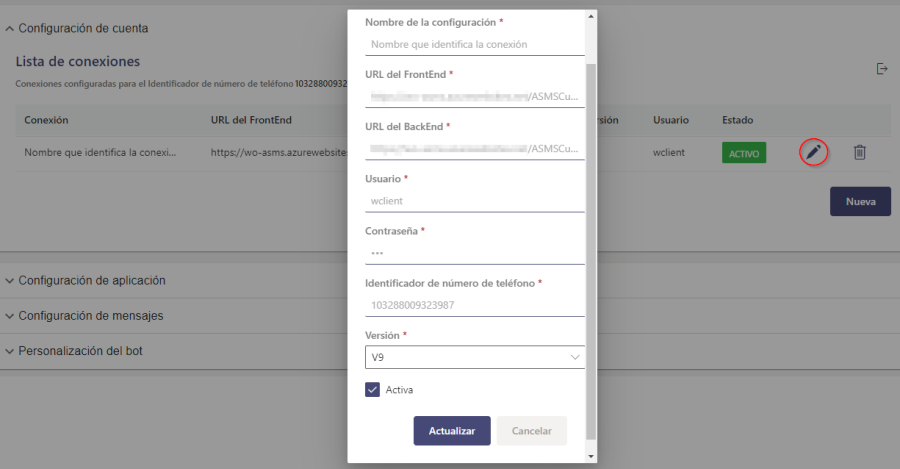
⚐ Note: If you see the message when you create or update your account settings, The entered BackEnd URL does not belong to an Aranda service; You must validate that the data entered in the URL del BackEnd correspond to the Aranda Service Management (ASMS) product environment.
Application configuration in the Bot environment
This section configures the data that was obtained during the configuration of the Meta Application and that the Bot will use to interact with users; The configuration must be made for each connection that exists within the environment. When all the fields are filled in, the configuration is completed by clicking on the Save.
It can be exchanged between the different configured connections by selecting them in the field Select the connection for which you are making the change; The last connection to be saved is the one that is kept as a connection Active.
| Field | Description |
|---|---|
| Permanent Access Token | Token that was saved when the Permanent token |
| Verification Token | The value to be entered is ArandaAdmin |
| Template Create Case | If the customer does not have a custom template, enter create_case_default_aranda, if you created custom template enter the name assigned to the template Create Case |
| Template see case | If the customer does not have a custom template, enter view_case_default_aranda, if you created custom template enter the name assigned to the template View case |
| Template to approve case | If the customer does not have a custom template, enter approve_case_default_aranda, if you created custom template enter the name assigned to the template Approve Case |
| Notification template (from Business Rules) | The customer must have a custom template, so they must enter the name assigned to the template Notification by Rule |
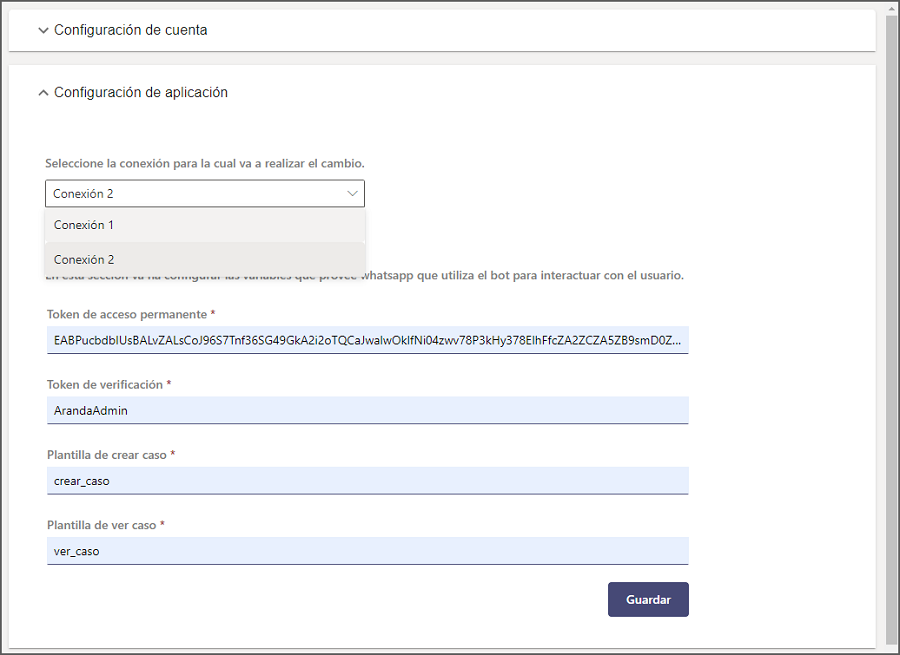
All fields are required; If the configuration is stored correctly, a message is displayed: Successfully updated application settings
Configuring messages in the Bot environment
In this section, the name of the Bot, the message of attention and the farewell message, which the Bot uses when interacting with users, can be customized in each culture (Spanish - English - Portuguese); The configuration must be made for each connection that exists within the environment. When all the fields are filled in, the configuration is completed by clicking on the Save.
It can be exchanged between the different configured connections by selecting them in the field Select the connection for which you are making the change; The last connection to be saved is the one that is kept as a connection Active.
| Field | Description |
|---|---|
| Bot Name | Name assigned to the Bot (maximum 46 characters). |
| Message of attention | The message that the Bot will use when it starts categorizing a case (maximum 1000 characters). |
| Farewell message | The message that the Bot will use when displaying the Create Case and View Case buttons (maximum 1000 characters). |
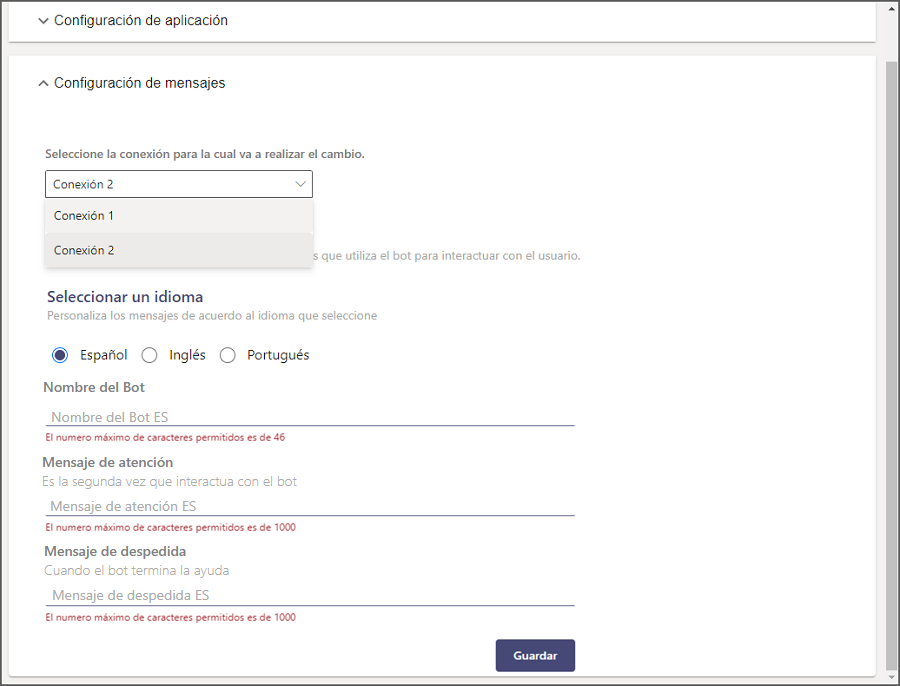
All fields can be filled out according to the needs that need to be customized; If the configuration is stored correctly, a message is displayed Correctly updated message settings.
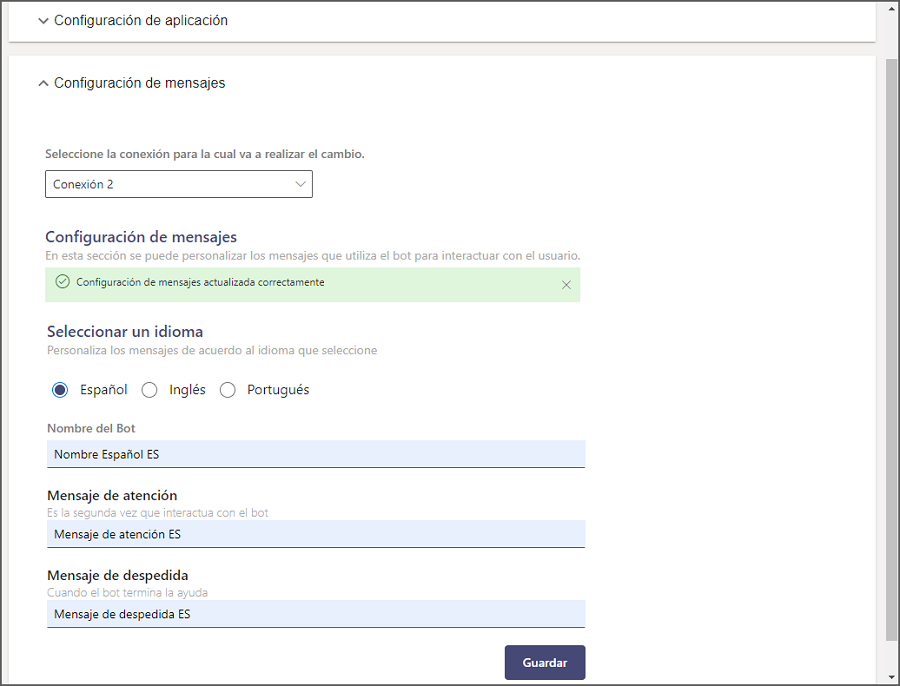
⚐ Note: If the changes are saved leaving the fields empty (Bot Name – Attention Message – Farewell Message), the default values that the Bot comes with preconfigured by each culture are set.
Bot customization
Configuration of AI functionalities
This section configures the behavior of the bot during case creation for automatic categorization,
the extraction of additional fields through a request sent by the user, the management of additional missing fields
and speech-to-text transcription. It is essential to remember that, for the optimal functioning of these functionalities,
You must have the corresponding endpoints and actions configured in the Admin console.
For more details, see AI Settings.
1. Go to the “Customizing the bot”. The active setting will be selected by default.
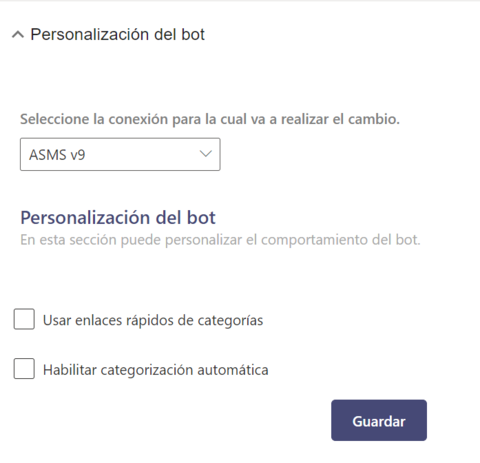
2. Select the connection for which you are going to customize the bot and enable the option “Enable automatic categorization.”
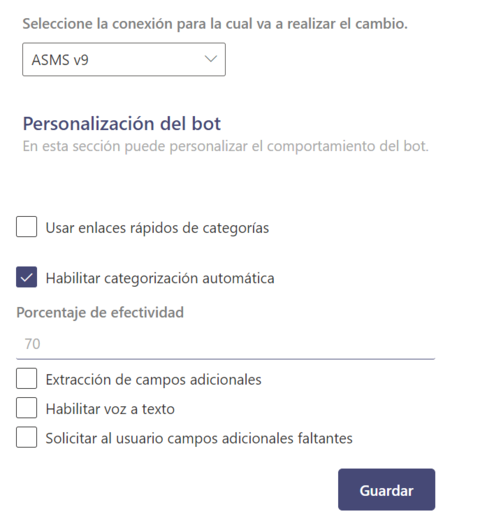
3. Two fields will be enabled:
- Extracting additional fields: Enable this option to perform value extraction for additional fields, during the request sent by the user.
- Extraction of list fields: Enable this option to perform value extraction for additional fields such as list and tree, during the request sent by the user, this field is displayed when activating the “Additional field extraction” option.
Use category quick links
When you activate the “Use category quick links” option, the Bot will display a list of direct links to the categories they have The check box is enabled “Category in the Home of users” on the administration website (ASMSAdministrator). See Services. In this way, the user only has to select an option and the Bot automatically generates the link or button (if you have custom templates configured) that allows you to create the case for that category.
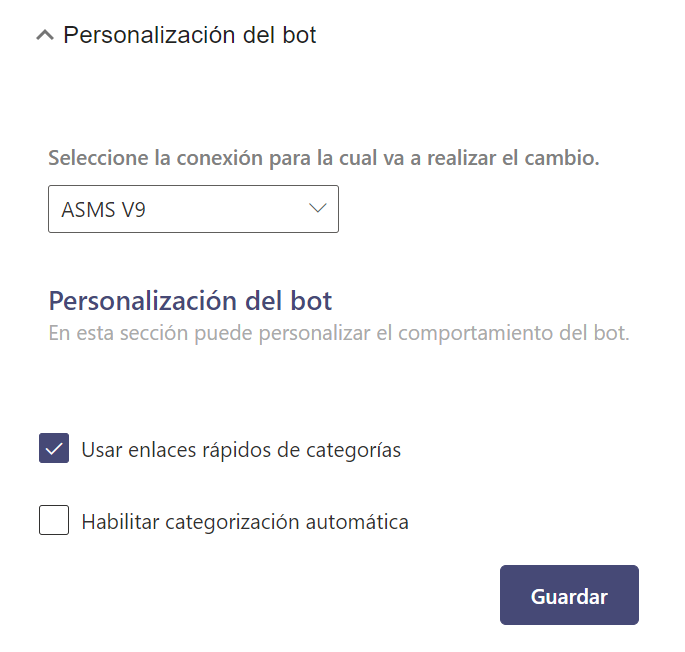
Enable speech-to-text: Enable the option if you want to perform automatic speech-to-text transcription for automatic case categorization.
Ask the user for additional missing fields: Enable this option if you want the bot to request the missing additional fields during case creation.


